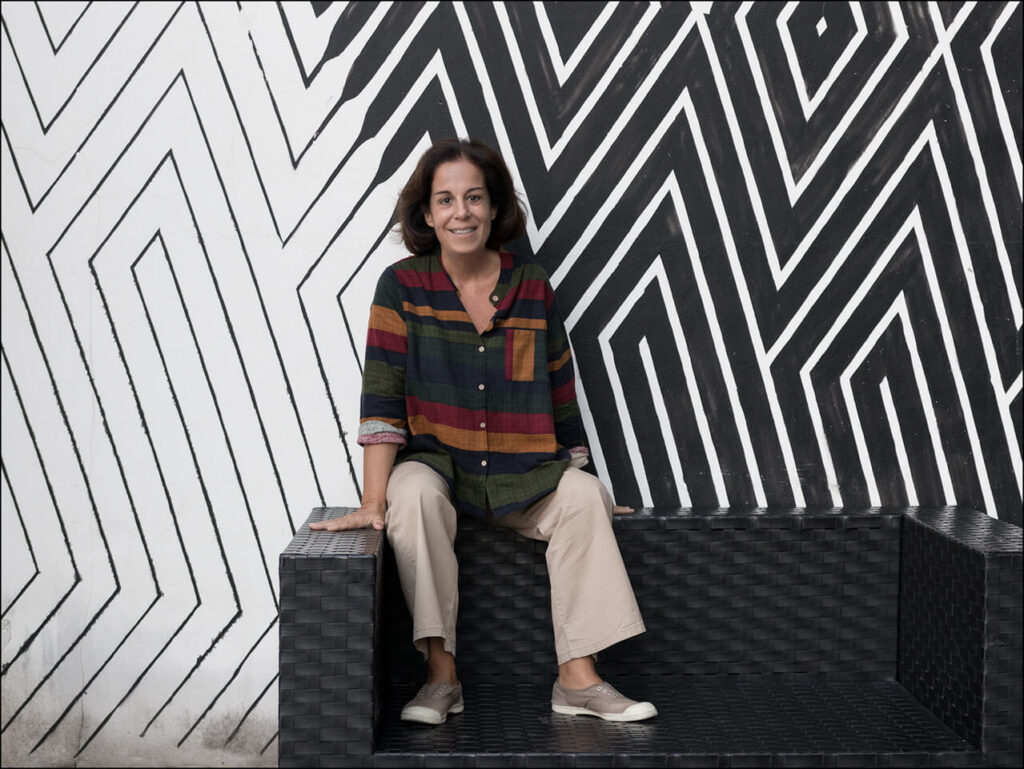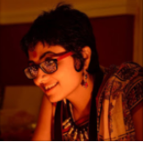
Born in Milan to a French father and an Italian mother, Mia has known crossroads, connections, and multiplicities of voices deeply since the beginning. A poet and a scholar, an author of children’s books and an activist, a translator and a storyteller, she is defined by being more than “definitions.”
She holds a doctorate in Italian Studies from the Sorbonne Nouvelle – Paris 3 University. She deals with Italian-speaking transnational literature and in particular with poetry, a form she weaves as an artist and critiques as a scholar. Her essay “Di un Poetico Altrove : Italian-speaking Transnational Poetry (1960–2016)” (2018) deserves a special mention here among many others that grace numerous collective volumes. Mia is also the curator of worthy anthologies such as “Sucj Ai confine dei verso,” “Poetry of Migration in Italian (2006),” “Always on the Edge of Verse, Poetic Dispatri in Italian (2011),” and, with Luigi Bonaffini, “A New Map: The Poetry of Migrant Writers in Italy (2011).”
Among her publications we must mention Meanwhile the Time (2012) and At the Museum of Interrupted Relationships (2016); among the children’s books L’Altracittà (2010) and Gli Spaesati/Les Dépaysée (2019). Translated into many languages, her poems have been published abroad and in Italy in magazines and anthological collections including Confluences Poétiques (Paris, Mercure de France, 2007–2008, n.2 – n.3), In Verse: Italian Poets in Translation (Rome, John Cabot University Press, 2008), Migrations: An Afro-Italian Night of the Poets (Ibadan, Bookcraft , 2013. Preface by Wole Soyinka ), Mana scrie sunetul (Bucarești, Eikon, 2014. Edited by Eliza Macadan), and Vuela alta palabra (Caza de Libros editores, Bogotá, 2015, vol.III – Las voces imprescindibles. Edited by Emilio Coco). Her poetic syllogs have been published in English (For the Maintenance of Landscape , 2012), in French ( Là où tu as ton corps, 2020. Prix Khoury Ghata 2021) and in Romanian ( Nuda Proprietate, 2020).
She was one of the founders of the online quarterly of migration literature El Ghibli and serves as the editor of the semicircle of comparative poetry Semicerchio and of the magazine of the Anglo-French poetry festival La Traductière.
In 2009 she founded the Compagnia delle poete, a poetic-theatrical group of Italian-speaking foreign authors who perform under the banner of transculturalism and artistic contamination.
Mia has contributed to Antonym since its early childhood, not just as a prolific writer and translator but being a great friend and advisor, one of our constant sources of motivation and faith as we grew. As Antonym steps into its long cherished journey in print, a space which shall hold the soul of our online self yet aiming to be more, be a space where we explore blurred edges of genres and languages, it felt only natural to turn to Mia with inquiries about writing life, languages, and art in general.
Born into more than one language, how do you feel about linguistic plurality?
Actually, there’s only one language I’ve ever written in, Italian. Over the years I’ve lived amid other European languages, especially French, but the only real linguistic plurality I possess is a reservoir of sounds I can draw on in relation to Italian. It’s a musical stash of possibilities, not just linguistic but expressive in a broader sense. A sort of private orchestra, poised to fill the air with some unknown timbre, that was waiting for those particular sounds in order to exist. The linguistic multiplicity deriving from journeys and migrations is a subject I’ve always dealt with as a scholar, particularly in terms of developments in the Italian-speaking world; but it’s always from the angle of the destination or target language, the only one I write in. Which over the years, more and more, has become the only place where I really exist. I think a writer or poet’s nationality no longer matters, and all we should look at is the literary language they use to express themselves. That’s the yardstick that should be used when putting together anthologies, for instance, or organizing festivals.
How does your academic background resonate with your creative self?
I studied the humanities—not as exotic a choice back in the day—which taught me to trace the movement of the human spirit over the centuries, through languages that never really died, and others that are now struggling to live. In the long view, humanity is always the same, both a miracle and a curse, creator and victim of its own words. My comparative studies at university, which focused above all on transnational literatures, led me deeper and deeper into the dynamics of identity and language. These questions have fed into my poetry, above all. They also prompted me to found the Compagnia delle Poete, an international theater ensemble made up of women poets, which explores these issues artistically; and the literary agency Linguafranca, which promotes the work of transnational authors in particular.
Can you tell us about your experience with translation? When did you start?
I began translating as a child, at home, with my father. He was a poet who wrote in French; although he’d been in Italy for many years, he never managed to make the switch to Italian. So as soon as I had some rudiments of schooling, he started asking me to help him bring his work into my language. “Listen to this,” he’d say, reading me one of his poems, “I want it to sound the same in Italian.” Then for days, for months, he’d keep going back to work on the solutions we’d come up with together. We argued a lot, and it was probably the only serious thing we argued about. It was an everyday emotional bond, over the years. Along with shared meals, books, movies, jazz. Even today, translation is one of my primary modes of expressing love. Toward the things I translate, above all, but also toward the people around me, above and beyond translation, in an almost physical way.
You are an artist with many forms at your disposal, including short stories, poetry, children’s literature, and translation. Which one are you most fond of? And which scares you?
It’s all part of the same flow, words that generate themselves by subtraction. In the sense that they surge out of the same creative vortex, to bear their little offspring. I can’t clearly identify the boundaries and strategies of these various offshoots, so I can’t fear them. Then again, in an era of linguistic plurality and migration like our own, I think it’s natural for indiscriminate circulation to jumble together different languages, genres, and forms of artistic expression.
There is an upsurge in hybrid artworks and literature these days. I personally feel this is a place we are probably reclaiming from the past, where it was quite natural and spontaneous for body, voice, language, and stories to be expressed through one another. We now have more mediums, that’s all. Would you like to comment?
That’s just what I was saying. In the past, it was indeed the body as a living presence—volume, color, weight, movement, sound—that in some sense ensured the plurality of expression. Today, given the ever more radical absence of bodies, we increasingly rely on hybrid forms and multimedia. But all that changes are the tools. The richness of human expression, the creative energy of its resources, always manages to find some new path over time.
What are the books on your desk now?
Right now, on my computer desk, I have several books of poetry that just arrived because I’m on a prize jury. And the edit of a book by an Iranian American poet, Kaveh Akbar, which I’ve translated from the English with Andrea Sirotti and we have to turn in soon. Whereas on my bedside table, I have Antonio, a wonderful novel by the Brazilian author Beatriz Bracher, translated into Italian by Prisca Agustoni.
Your book of poems, Home Is What Is Left, combines photographs and poems. I found the juxtaposition intriguing and wanted to know how you conceived them. Did the images come first, or the poems?
Poetry and photography have always been constant companions. I started writing and taking pictures when I was a little girl. In periods when I’m writing, I generally don’t take photos, and vice versa. Poetry and photography shore each other up in what they say and don’t say. They take turns hiding me, making room for what exists beyond me. I don’t think of myself as a photographer, since I don’t have the technical grounding; and maybe I’m not even a poet. I’m a sort of ventriloquist amazed by the voices inside her, by how they come out and manifest themselves. When I intentionally, consciously try to combine these voices and bring them into dialogue, I do it by following this instinct of amazement, which is tied to the deepest, most unexplored part of myself. And in the case of Home Is What Is Left, there’s also Brenda Porster’s translation, another creative layer that interfaces with and is superimposed on the rest.
What brought you to children’s literature?
Children themselves, especially my own. But also others, whom I enjoy having around. I’ve noticed over the years that my books for children all take a more explicit “stance” on social issues. As if addressing children, becoming a child again, were the only way for me to clearly see what I don’t like, and find the simplest, most direct words to express that—humor always plays a fundamental role. And also because most of them are in verse, in rhyme, allied with illustrations that are almost all the work of my main accomplice, the extraordinary Andrea Rivola (http://andrearivola.blogspot.com/).
Being a translator and a writer, what do you think of self-translation?
Self-translation is a complex process that implies rewriting. An author has to have two or more languages that they deeply feel are necessary—there’s only one mother tongue—and have the other corresponding authors within themselves, capable of moving towards another text. As I said, I’m actually monolingual; my Italian won’t allow me any kind of schizophrenia as an author, and tyrannically calls me back to myself.
You have been with Antonym since its early days. We have been working to bring Bengali and other vernacular language literatures from India to a global audience through translation. How do you feel about our works or the translations?
I’m not capable of judging the translations from Indian languages, but I’m impressed by how The Antonym has grown in such a short time. It’s truly transnational and open, dynamic, flexible, with excellent authors, and aesthetically sophisticated. I can’t thank my friend Pina Piccolo enough for having put me in touch with such a vibrant, innovative project.
Also read :


























0 Comments